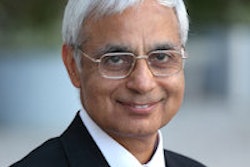
Cardiologists and radiologists tend to stick rigidly to their own specialty's congresses, but this may soon change after the European Society of Radiology (ESR) has held out the hand of friendship to the European Society of Cardiology (ESC).
 Radiologists must know more about cardiac imaging, particularly the uses of newer hybrid systems, according to Dr. Valentin Sinitsyn.
Radiologists must know more about cardiac imaging, particularly the uses of newer hybrid systems, according to Dr. Valentin Sinitsyn.
Success in cardiac imaging can only be achieved with closer collaboration and more teamwork between cardiologists and radiologists, according to ECR 2014 President Dr. Valentin Sinitsyn, professor and head of the radiology department at Moscow's Federal Center of Medicine and Rehabilitation. As someone who has had a foot in each camp in the past, having worked previously at the Cardiology Research Center in Moscow, Sinitsyn is relishing the prospect of now acting as a bridge and a peacemaker between cardiology and radiology.
"Cardiologists and radiologists quite often work side-by-side in the field of imaging and their cooperation has already resulted in many outstanding breakthroughs in the workup of many cardiac diseases," he said. "We are happy to welcome such a large and successful society as the ESC to Vienna."
The ground-breaking ESR meets ESC session, to be held on Saturday, 8 March, at ECR 2014, will focus on the role of imaging in the cardiac patient. Among the topics to be addressed will be how to assess myocardial viability, evaluating acute chest pain, and assessing valvular heart disease and interventions. ESC President Dr. Panos Vardas from Iraklion, Greece, will give an introduction and will moderate the session along with Sinitsyn.
Sinitsyn hopes the ESC session will help to convince general radiologists that they need to learn more about cardiac imaging and show them that they can work more closely with cardiologists. Unless they acquire more cardiac know-how, including about the potential benefits of newer hybrid systems, cardiologists are unlikely to refer their patients to the radiology department, he said.
Other new features at ECR 2014:
A multimedia classroom involving case-based mentored teaching about topics such as cardiac CT, CT colonography, multidetector CT in trauma, and oncologic imaging. The aim is to provide direct training on workstations for the interpretation of cases. 2D and 3D image review and processing will be covered, as well as the essential steps in the radiological workflow that lead to the final diagnosis and report.
A professional challenges session about the role of social media in radiology (PC 11, Saturday, 16:00-17:30). Also, the ECR Live and Social Media Wall projects will be extended.
Case-based diagnosis teaching, to be held on the last day of the congress (Monday). This will consist of two interactive sessions with case presentations and discussions from Austrian presenters. The initiative is directed at residents and young radiologists.
The official launch of EuroSafe Imaging, a campaign intended to promote the use of diagnostic reference levels, observance of the ALARA (as low as reasonably achievable) principle, and general appropriateness in imaging. ESR has organized a special exhibition and session about dealing with the challenges of radiation protection. "In the coming years, I expect radiation protection to take on a higher profile wherever the ESR is concerned," ESR President Dr. Guy Frija noted.
 The ESR executive council, shown here in January 2014, has announced its commitment to make radiation protection a top priority. The official launch of the EuroSafe Imaging campaign will be a highlight of ECR 2014.
The ESR executive council, shown here in January 2014, has announced its commitment to make radiation protection a top priority. The official launch of the EuroSafe Imaging campaign will be a highlight of ECR 2014.A minicourse on emergency radiology, organized by the ESR and RSNA. Two other minicourses are on interventional and skeletal radiology.
New horizons sessions on subjects such as imaging the hallmarks of cancer, imaging in precision medicine, and the human connectome (a comprehensive map of brain connections). There are many sessions about oncology, such as tumor response assessment in clinical practice (SA 15), according to Sinitsyn.
Editor's note: In the third part of our series of articles looking forward to ECR 2014, we will be asking AuntMinnieEurope.com's editorial advisers for their thoughts and observations about the congress. Check back for part three next week.



















